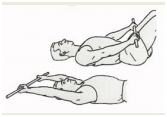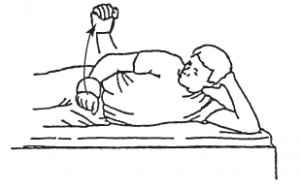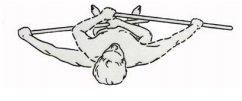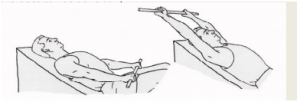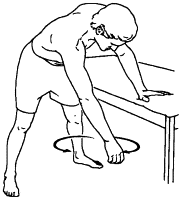Rotator Cuff Tendinopathy
Original Editors - Miguel Gonzalez-Rodriguez as part of the Vrije Universiteit Brussel Evidence-based Practice Project
Top Contributors - Miguel Gonzalez-Rodriguez, Naomi O'Reilly, Shauni Van Overstraeten, Admin, Tim Secretin, Kim Jackson, Jan Alderweireldt, Tarina van der Stockt, Fasuba Ayobami, Rachael Lowe, Simisola Ajeyalemi, Lucinda hampton, Jess Bell, Uchechukwu Chukwuemeka, Wanda van Niekerk, Evan Thomas, Margaux Jacobs, Kai A. Sigel, Anthony Mertens, 127.0.0.1 and Lauren Lopez
Definition/Description
Rotator Cuff Tendinopathy, according to Lewis et al [1], "refers to pain and weakness, most commonly experienced with movements of shoulder external rotation and elevation, as a consequence of excessive load on the rotator cuff tissues". The patho-etiology of rotator cuff tendinopathy is multifactorial and can be attributed to extrinsic and intrinsic mechanisms, as well as to environmental factors. Rotator cuff tendinopathy is not a homogenous entity because of the diverse nature of the factors involved and hence, different treatment interventions are required, which take these specific mechanisms/factors into account.
Clinically Relevant Anatomy
The Rotator Cuff is a common name for the group of 4 distinct muscles and their tendons that provide strength and stability during motion of the shoulder. The muscles arise from the scapula and connect to the head of the humerus, forming a cuff at the glenohumeral joint. Cranial to the rotator cuff, there is a bursa that covers and protects the muscle tendons as they are in close contact to the surrounding bones.[2] The rotator cuff muscles include: [3]
| Origin on Scapula | Insertion on Humerus | Primary Function | |
|---|---|---|---|
| Supraspinatus | Supraspinous Fossa | Superior Facet of Greater Tuberosity | Abduction |
| Infraspinatus | Infraspinous Fossa | Middle Facet of Greater Tuberosity | External Rotation |
| Teres Minor | Lateral Border of Scapula | Inferior Facet of Greater Tuberosity | External Rotation |
| Subscapularis | Subscapular Fossa | Lesser Tuberosity of Humeral Neck | Internal Rotation |
Epidemiology
A prevalence up to 30% experience shoulder pain in their lives and up to 50% of the population experience at least one episode of shoulder pain annually. We can say that shoulder disorders are extremely common. 54% of people with shoulder disorders reports symptoms are still present after three years. [4] Rotator Cuff Tendinopathy is seen as the most common type of shoulder pain as it is seen in about 30% of the overall population. [5]There is an increased incidence of shoulder pain in individuals who participate in repetitive overhead activities including repetitive throwing sports like baseball or volleyball, occupations such as painting or carpentry. Rotator Cuff Tendinopathy incidence also increases with age, which needs to be considered when we talk about Rotator Cuff disorders. The following conditions can be grouped under the term Rotator Cuff Tendinopathy: "tendinitis, tendinosis, paratendinosis or partial tears of the Rotator Cuff tendons" and should exclude: "subacromial impingement syndrome, subdeltoid bursitis, adhesive capsulitis and full thickness tears"[5].
Occupational Risk Factors:[6][edit | edit source]
Awkward Postures
Static Postures
Heavy Work
Direct Load Bearing
Repetitive Arm Movements
Working with hands above shoulder height
Lack of Rest
Risk Factor for Tendinopathy:[edit | edit source]
Metabolic Disorders: Non-familial Hypercholesterolaemia, Diabetes [8]
Muscle Imbalance
Decreased Flexibility
Overweight
Advancing Age
Certain Sports (Repetitive Arm Motion) [9]
Etiology[edit | edit source]
According to Lewis et al[1] the definitive cause for Rotator Cuff Tendinopathy remains uncertain but proposed mechanisms include intrinsic, extrinsic or combined factors as can be seen in Figure.1 below.
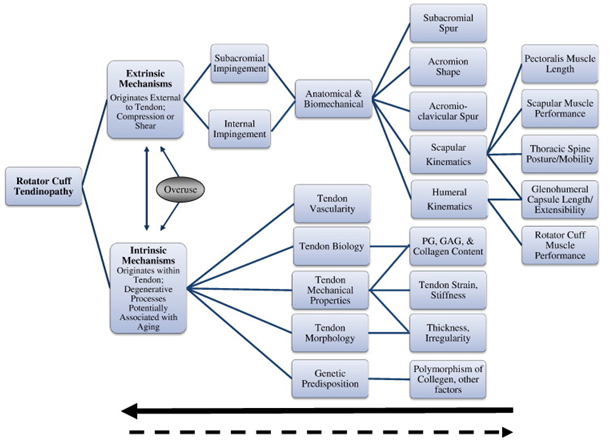
Extrinsic factors are caused by compression on the rotator cuff tendon, the bursal side and encroach upon the subacromial space. This compression can be caused by anatomical variants of the acromion, alterations in scapular or humeral kinematics, postural abnormalities, rotator cuff and scapular muscle performance deficits and decreased extensibility of the pectoralis minor or posterior shoulder. There is also an unique extrinsic mechanism, termed internal impingement where there is compression of the posterior articular surface of the tendons between the humeral head and glenoid and which is not related to the subacromial space narrowing. [11][12] Muscle fatigue or weakness could lead to the narrowing of the subacromial space and thus rehabilitation could address this. [5]
Intrinsic factors that contribute to rotator cuff tendon degradation with tensile or shear overload are alternations in biology, mechanical properties, morphology and vascularity. So the intrinsic factors have an influence on the morphology and performance of the tendon.[11][12] Age, genetics and poor biomechanics are also considered intrinsic factors, and an increase in load on the tendon is seen as the most important. [5]
Characteristics/Clinical Presentation
The symptoms or characteristics of rotator cuff tendinopathy are pain in the area of the four rotator cuff tendons and tenderness located in the shoulder-joint with a dull character, especially when you’re reaching overhead, reaching behind your back, lifting and sleeping on the affected side. More relevant in elevation of the shoulder and abduction, unable to reach higher than 90° abduction, anteflexion of the upper arm. The ADL-activities can cause quite a bit of pain. The pain is not sudden but will gradually increase and is been there for some time. Associated with pain is the growing weakness of your shoulder and immobility to move.[13] [14] There could also be a local swelling.
Differential Diagnosis
Shoulder pain is a common presenting problem with a number of different causes, it is essential to determine the difference between a rotator cuff tendinopathy and some fo the following shoulder problems;
- Adhesive Capsulitis (Frozen Shoulder)
- Biceps Rupture
- Bicipital Tendinopathy
- Cervical Disc Disease
- Cervical Spondylosis
- Cervical Sprain and Strain
- Complex Regional Pain Syndromes
- Osteoarthritis
- Rheumatoid Arthritis
- Shoulder Pain in Hemiplegia
- Thoracic Outlet Syndrome
Diagnostic Procedures[edit | edit source]
Diagnosing is based on several aspects like the history of the patient. In addition, tests will be used to implicate an isolated structure. The diagnose of a rotator cuff tendinopathy will be achieved, based on the response the the clinical tests. Supporting examinations like ultrasound, radiographs, radionucleotide isotope scan, magnetic resonance imaging (MRI), computed axial tomography (CT), electromyography, nerve conduction, single photon emission computed tomography, diagnostic analgesic injection and blood tests are sometimes used to strengthen the diagnosis.[4]
Diagnostic ultrasound is considered the best tool to diagnose Rotator Cuff Tendinopathies. [5] An MRI-scan can also be used to diagnose Rotator Cuff problems.[5] It is not standard procedure, but it will give you more information about the weak tissue in that area. So it will give you an idea if there is something not right with the tendons, the joint and the muscles. You can also take an echo to determine if there is something wrong.
Outcome Measures
An Visual Analogue scale is used to describe pain in the shoulder-joint after the joint is palpated by the physiotherapist. This is not the only one, you can also use the Shoulder Pain And Disability Index (SPADI). A questionnaire filled in by the patient.[15]
Examination[edit | edit source]
Two clinical test can be performed to assess Rotator Cuff tendinopathy.[16][17]
The first is called the “Empty Can test”. The patient stands up with his shoulders in 90°abduction, 30° horizontal adduction and in complete end of rotation. The therapist fixates his hands on the upper arm of the patient and gives downward pressure while the patient tries to maintain his position.
In the “Hawkin’s Test”, the patient is standing up with the shoulders abducted in 90° and internally rotate the fore arm. The presence of pain with movement is an indicator of a possible pathology.
With the modified Belly Press Test the patient stand or sit with the affected hand flat on the abdomen and elbow close to the body. The patient need to bring the elbow forward and straighten the wrist. the final belly-press angle of the wrist need to be measured with a goniometer. A belly-press angle difference of 10° between affected and unaffected side indicates a tendinopathy.[18][19]
Medical Management[edit | edit source]
There can be different treatment used in medical management. But not all are strongly evidence based. The use of non-steroidal anti-inflammatory drugs (NSAID’s) like ibuprofen and aspirin may have a pain reducing effect. As second you have the corticosteroid injections who are a commonly administered treatment for tendon disorders. But have also side-effects like skin atrophy, oversensitivity at the place of the injection and discoloration of the skin. Repetitive injections will also weaken the structure of the tendons. Medical examiners often prescribe immobilization. And the last medical management is surgical treatment, very good results were achieved with surgery, but will only be chosen if conservative treatment doesn’t work.
Studies show that there may be no difference in pain between surgery and different exercise programs. There would be also no difference in end-result between an open surgery and arthroscopic surgery but people might recover sooner with arthroscopic surgery. There might be also several side effect after the surgery like pain, infection, difficulty moving the shoulder after the operation, wasting of the shoulder muscle, and the need to have another surgical procedure. Those side effects were independent of the type of surgery (open or arthroscopic). [20]
The effect of of subacrmial corticosteroid injection is sustained by the available evidence. Although the effect may be small and short-term. Furthermore, it wouldn’t be better than NSAID.
Also the effects of localized microwave diathermy on disability, shoulder function and pain are equivalent to those elicited by subacromial corticosteroid injections.[21]
Further the injection of platelet-rich plasma also proves to be effective for significant improvement on pain, function and pain outcomes.[22]
Physical Therapy Management
Physical therapy of rotator cuff problems reduces pain and swelling of the tendons, gaining again your normal range of motion and eventually getting your shoulders again strengthened. The first step before the actual treatment is enough rest and putting ice on the affected shoulder. It’s very important that in the beginning the patient avoids activities that aren’t promotional for the shoulder. He can slowly start them up again if he feels that he is ready. That will be talked about with the physiotherapist.
The physiotherapist can use massage and deep frictions to prepare the muscles for the range of motion and strength exercises. He does that to relax the muscles because they probably will be stiff. It’s important that you practice your exercises in the correct order. Meaning first stretching and range of motion exercises and then muscle strength exercises.
It has been shown that exercises are effective and support the improvement of the shoulder tendinopathy compared to no treatment or placebo.[23]
Stretching and range of motion exercises : - pendulum stretching exercise: helps to stretch the space in which the tendons pass and exercise fully extend the arm at shoulder height 90° from the body -posterior capsule stretching: reach with your affected arm across your body and use the other arm to pull the affected arm closer to your body.
Studies have shown that other interventions like laser-and ultrasound therapy don’t support the effectiveness of therapy progression.[23]On the other hand benefit from ESWT (Extracorporeal shock wave therapy) has been demonstrated in calcific tendonitis of the rotator cuff.
We can also bring shock wave therapy into the physical treatment at this stage of the treatment. After a while when the symptoms allow it (5-6 weeks) depending from patient to patient, you can begin by giving strengthening exercises. They are necessary to prevent further injury.
Some exercises are:
[24]- scapular squeezes - outward rotation exercise - inward rotation exercise - abduction exercise
Once the rehabilitation is complete it is important to keep the shoulder muscles strong to maintain fitness and to prevent injury. Most people with rotator Cuff Tendinopathy see improvement after 6-12 weeks of rehabilitation.[25] [26]
Information, advice and instructions
Rotator Cuff Tendinopathy indicates a problem with your shoulder muscles. It can be caused by an overload of the four muscles located in that region, or an inflammation of one of the tendons. Other causes of a tendinopathy can be found in impingement of the bursa and calcification of the tendons from the rotator cuff muscles.Exercises
-Mobilization exercise with a cane
At the beginning of the training program, patients have a lack of range of motion. Active assisted motion may for instance be performed with a cane. It is important that the exercises are performed within the pain limits.[27] Start position: The patient lies on his back, with bended knees, on the table with the cane in his two hands. He puts his unaffected arm at the bottom of the cane and the affected arm at the top.Exercise: The patient moves the cane with his unaffected arm. He brings his affected arm slowly upwards and downwards and repeats the exercise 25 times. (Elevation and depression)[28][29]
Other movements: external rotation and abduction
Upon external rotation the patient also lies on his back on the table with a cane in his hands. The elbows are bend in ninety degrees. Just like in the other exercise, it’s the unaffected arm that moves the other arm in external rotation.
For abduction the patient moves the cane as far as possible away from the body without compensation.
You can make this exercise more difficult when you ask the patient to lie on a 45° support or to perform the exercise in a standing position.
The frequency of every exercise is 2-3 times a day, every day.
Exercise without a cane
To improve the range of motion with rotator cuff tendinopathy we can start performing pendulum exercises. To do this you must lean with your non-affected arm on a table. The affected arm is just hanging and you let it dangle. Then you can make different figures with your arm, so it swings like a pendulum. You can make small or large circles (clockwise or counterclockwise), you can go forward and backwards or from side to side. It is important that the patient doesn’t make this an active exercise, but assures these movements are generated by trunk motion.[30] The muscles must be completely relaxed. Do this exercise for about 3 minutes and move your arm about 10 to 20 cm in each direction. In addition, pendulum exercises can be initiated during this time. These can be done at home, twice a day.[31]
- Resistance training to increase the mobility
It is proven that resistance training can be used to increase mobility. It was also proved that improving strength was associated with an improvement of other factors, namely: muscle and bone mass, balance, and also mobility. Those factors are important in our daily life.[32] As such, resistance exercise training is a suitable means to increase muscle size, strength and mobility. The gains from this training are variable and will be better in younger than in older adults.[33]
Strength training
You can start with strength training when the patient demonstrates adequate passive and active glenohumeral range of motion, absent of substitution patterns, with acceptable scapulothoracic kinematics
The patient progresses to isotonic and light closed chain stability exercises. The internal and external rotators are strengthened by utilizing said motions with the arm below shoulder height accompanied by elastic resistance and a towel roll placed between the arm and trunk to encourage proper technique, thereby minimizing substitution patterns.
For training the M. serratus anterior you perform the bear hug exercise. You stand with the back toward the wall, knees slightly bent, and the feet shoulder-width apart. You flex your elbows to 45°, the arms are abducted 60° out from the trunk, and the shoulder is internally rotated to 45°. The patient then performs horizontal adduction of both upper extremities, following an imaginary arc at approximately 60 degrees of elevation until they obtain maximum scapular protraction by touching their fists together as to mimic a hugging motion around a cylindrical object. Afterwards you return to starting position.
For strengthening the trapezius and rhomboid musculature you perform the sport row cord exercise.
You stand still and pull the cords till your forms 90° with your humerus, which directs downwards, and your radius and ulna, which directs forward.
Advanced training of the muscles
When you start with these exercises the remodeling phase is almost complete, and the rotator cuff tissue almost mature. The patient should be pain free with activities of daily living. In addition, the patient must not show dyskenisia when performing active motions at multiple angles.
Progressive strengthening of the posterior rotator cuff muscles, is accomplished by performing an exercise. You stand in a standing position, while performing external rotation of the shoulder at 45 degrees of abduction utilizing elastic resistance. By performing this exercise you ensure high levels of activation of the Teres Minor and the Infraspinatus. The supraspinatus muscle is optimally generated, by perfoming external rotation at 90° of abduction.
To strengthen the serratus anterior further, you perform an exercise standing, facing away facing away from the elastic resistance attachment with the hands held at shoulder width and chest height, holding onto the resistance band or cord. Next, the upper extremities are extended forward away from the body similar to a bench press motion at approximately 120°of a forward elevation followed by protraction of the scapula. In addition the push- up with a plus progression strengthens the serratus anterior even further. It begins with gradually increasing the gravity resistance. It starts by pressing against a wall , then an edge and eventually the floor.
Advanced rhythmic stabilization
The patient stabilizes their upper extremity in a position of 90° of external rotation and 90° of forward elevation in the scapular plane. Once in this position the patient must maintain this position against elastic oscillations with a rubber bar. Additionally, advanced closed chain stability exercises are performed in the quadruped position, while stepping on and off steps of various hights and angles. Propioceptive neuromuscular facilitation can be implemented to continue the progression of rhythmic stabilization.
c) Self-managed exercise program
This is a self-managed exercise program to address pain and disability associated with rotator cuff tendinopathy. There are several subdivisions in the program namely; week 0, week 3-4, week 6-8 and week10-12. Each subdivision has its own exercises and its own difficulties. It is important to follow the program correctly and to properly apply the exercises[34][35]
The exercises are prescribed by a physiotherapist but independently performed by the patient. It involves exercising the affected shoulder against gravity, a resistive therapeutic band or hand weight. It should be executed twice a day over 3 sets of 10 to 15 repetitions. This exercise can be uncomfortable for the patient but is prescribed to ensure the discomfort is manageable[36]
Self-managed exercise program:
Week 0: Baseline assessment & start of treatment
Resisted isometric shoulder abduction (or lateral rotation or flexion etc) against a wall, or resisted shoulder abduction from 0°-30° using moderate resistance from Theraband.
Week 3-4: initial follow-up & progression
Resisted shoulder abduction from 80 to 120° using light weight, e.g. tin of food.
Week 6-8: Second follow-up & progression
Resisted shoulder abduction from 80 to 120° with progressively increasing repetition and weight, e.g heavy Theraband or dumbbell.
Week 10-12: Final follow-up & discharge
Final assessment to identify any non-resolved functional limitations and progress loaded exercises as required, e.g. press-up, pull-up.
Recent Related Research
References
- ↑ 1.0 1.1 Lewis J, McCreesh K, Roy JS, Ginn K. Rotator Cuff Tendinopathy: Navigating the Diagnosis-Management Conundrum. Journal of Orthopaedic & Sports Physical Therapy. 2015 Nov;45(11):923-37.
- ↑ Di Giacomo G., Pouliart N.,Costantini A.,De Vita A., Atlas of Functional Shoulder Anatomy, Springer, Italy, 2008, 232 p. (Level of Evidence 5)
- ↑ Gray,H. Anatomy of the Human Body. Philadelphia: Lea and Febiger, 1918; Bartleby.com, 2000
- ↑ 4.0 4.1 Lewis JS. Rotator Cuff Tendinopathy/Subacromial Impingement Syndrome: Is it Time for a New Method of Assessment? Br J Sports Med 2009;43(4):259-64
- ↑ 5.0 5.1 5.2 5.3 5.4 5.5 Abat F, Alfredson H, Cucchiarini M, Madry H, Marmotti A, Mouton C, Oliveira JM, Pereira H, Peretti GM, Romero-Rodriguez D, Spang C. Current trends in tendinopathy: consensus of the ESSKA basic science committee. Part I: biology, biomechanics, anatomy and an exercise-based approach. Journal of experimental orthopaedics. 2017 Dec;4(1):18. Available from: https://www.ncbi.nlm.nih.gov/pmc/articles/PMC5449348/ [Accessed 2 May 2018]
- ↑ Sommerich CM, McGlothlin JD, Marras WS. Occupational Risk Factors Associated with Soft Tissue Disorders of the Shoulder: A Review of Recent Investigations in the Literature. Ergonomics. 1993 Jun 1;36(6):697-717.
- ↑ Gaida JE, Ashe MC, Bass SL, Cook JL. Is Adiposity an Under‐recognized Risk Factor for Tendinopathy? A Systematic Review. Arthritis Care & Research. 2009 Jun 15;61(6):840-9.
- ↑ 8.0 8.1 Abate M, Schiavone C, Salini V, Andia I. Occurrence of Tendon Pathologies in Metabolic Disorders. Rheumatology. 2013 Jan 11;52(4):599-608.
- ↑ Cohen RB, Williams Jr GR. Impingement Syndrome and Rotator Cuff Disease as Repetitive Motion Disorders. Clinical Orthopaedics and Related Research. 1998 Jun 1;351:95-101.
- ↑ Seitz AL, McClure PW, Finucane S, Boardman ND, Michener LA. Mechanisms of Rotator Cuff Tendinopathy: Intrinsic, Extrinsic, or Both?. Clinical Biomechanics. 2011 Jan 1;26(1):1-2.
- ↑ 11.0 11.1 Seitz AL, McClure PW, Finucane S, Boardman ND, Michener LA. Mechanisms of Rotator Cuff Tendinopathy: Intrinsic, Extrinsic, or Both?. Clinical Biomechanics. 2011 Jan 31;26(1):1-2.
- ↑ 12.0 12.1 Lewis JS. Rotator Cuff Tendinopathy: A Model for the Continuum of Pathology and Related Management. British Journal of Sports Medicine. 2009 Apr 12.
- ↑ Szczurko O, Cooley K, Mills EJ, Zhou Q, Perri D, Seely D. Naturopathic treatment of rotator cuff tendinitis among Canadian postal workers: a randomized controlled trial. Arthritis Care & Research. 2009 Aug 15;61(8):1037-45.
- ↑ Silverstein BA, Viikari-Juntura E, Fan ZJ, Bonauto DK, Bao S, Smith C. Natural course of nontraumatic rotator cuff tendinitis and shoulder symptoms in a working population. Scandinavian journal of work, environment & health. 2006 Apr 1:99-108.
- ↑ Roach KE, Budiman‐Mak E, Songsiridej N, Lertratanakul Y. Development of a Shoulder Pain and Disability Index. Arthritis & Rheumatology. 1991 Dec 1;4(4):143-9.
- ↑ http://www.nismat.org/orthocor/exam/shoulder.html
- ↑ Hughes PC, Taylor NF, Green RA. Most Clinical Tests Cannot Accurately Diagnose Rotator Cuff Pathology: A Systematic Review. Australian Journal of Physiotherapy. 2008 Dec 31;54(3):159-70.
- ↑ Nitin B. Jain, MD, MSPH1, Reginald Wilcox, PT, Jeffrey N. Katz, MD, MS, and Laurence D. Higgins, MD. Clinical Examination of the Rotator Cuf,manuscript, 5 january 2013
- ↑ Cortney A Myer, Eric J Hegedus, Daniel Thomas Tarara, Daniel M Myer. A User's Guide to Performance of the Best Shoulder Physical Examination Tests, British Journal of Sports Medicine, 2013
- ↑ Coghlan JA, Buchbinder R, Green S, Johnston RV, Bell SN. Surgery for rotator cuff disease. Cochrane Database Syst Rev 2008;(1):CD005619 (level of evidence 1A)
- ↑ Alessia Rabini, MD, PhD1, Diana B. Piazzini, MD1, (2012) Effects of Local Microwave Diathermy on Shoulder Pain and Function in Patients With Rotator Cuff Tendinopathy in Comparison to Subacromial Corticosteroid Injections: A Single-Blind Randomized Trial. Journal of Orthopaedic & Sports Physical Therapy Volume: 42, pages: 363-370
- ↑ Michael Scarpone, David Rabago, (2013) Effectiveness of platelet-rich plasma Injection for rotator cuff tendinopathy: a prospective Open-label study. Glob Adv Health Med
- ↑ 23.0 23.1 Chris Littlewood, Stephen May and Stephen Walters, (2013) Systematic Reviews of the Effectiveness of Conservative Interventions for Rotator Cuff Tendinopathy, review
- ↑ Physiotutors. Best Shoulder Pain Relief Exercises | Rotator Cuff Tendinopathy. Available from: https://www.youtube.com/watch?v=npIr82HHjXA
- ↑ Speed CA(1), Richards C, Nichols D, Burnet S, Wies JT, Humphreys H, Hazleman BL. Extracorporeal shock-wave therapy for tendonitis of the rotator cuff. A double-blind, randomised, controlled trial J Bone Joint Surg Br. 2002 May;84(4):509-12
- ↑ Rechardt M, Shiri R, Karppinen J, Jula A, Heliövaara M, Viikari-Juntura E. Lifestyle and metabolic factors in relation to shoulder pain and rotator cuff tendinitis: a population-based study. BMC Musculoskelet Disord. 2010 Jul 20;11:165. doi: 10.1186/1471-2474-11-165
- ↑ MICHAEL D., BAMG PT1, GAIL D., DEYLE; Comparison of Supervised Exercise With and Without Manual Physical Therapy for Patients With Shoulder Impingement Syndrome; Journal of Orthopaedic & Sports Physical Therapy 2000;30(3):126-137
- ↑ TODD S., ELLENBECKER, TETSURO SEYOSHI, MATTHEW WINTERS, DAVID ZEMAN; Descriptive report of shoulder range of motion and rotational strength six and 12 weeks following arthroscopic superior labral repair; North American journal of sports physical therapy, may 2008 ,volume 3, number 2.
- ↑ JOHN E.KUHN, MD, NASHVILLE, TN; Exercise in the treatment of rotator cuff impingement: Asystematic review and a synthesized evidence-based rehabilitation protocol; Journal of Shoulder and Elbow Surgery, 2008
- ↑ JOY L. LON, RAMIN A. RUBERTE THIELE, JACK G. SKENDZEL, JONGEUN JEON, RICHARD E. HUGHES, BRUCE S. MILLER, JAMES E. CARPENTER; Activation of the Shoulder Musculature During Pendulum Exercises and Light Activities; Journal of ortopaedic & sports physical therapy; april 2010; Volume 40; Number 4; 230-237
- ↑ MARKUS WALTHER, ANDREAS WERNER, THERESA STAHLSCHMIDT, RAINER WOELFEL, FRANK GOHLKE; The subacromial impingement syndrome of the shoulder treated by conventional physiotherapy, self-training, and a shoulder brace: Results of a prospective, randomized study; J shoulder elbow surg; juli/augustus 2004; Volume 13; nummer 4; 417-423
- ↑ E C RHODES1, A D MARTIN1, J E TAUNTON2, M DONNELLY3, J WARREN3, J ELLIOT3, ‘Effects of one year of resistance training on the relation between muscular strength and bone density in elderly women’, Br J Sports Med, 2000 (LoE 2b)
- ↑ MICAH J. DRUMMOND,* ROBIN L. MARCUS, AND PAUL C. LASTAYO, ‘Targeting Anabolic Impairment in Response to Resistance Exercise in Older Adults with Mobility Impairments: Potential Mechanisms and Rehabilitation Approaches’, J Aging Res, 2012 September 11
- ↑ LITTLEWOOD C, ASHTON J, CHANCE-LARSEN K, MAY S, STURROCK B: Exercise for rotator cuff tendinopathy: a systematic review, Physiotherapy. June 2012. (LoE 1a)
- ↑ P M LUDEWIG, J D BORSTAD, Effects of a home exercise programme on shoulder pain and functional status in construction workers; ‘ Occup Environ Med 2003,
- ↑ LITTLEWOOD C., ASHTON J., MAWSON S., MAY S., WALTERS S.; A mixed methods study to evaluate the clinical and cost-effectiveness of a self-managed exercise programme versus usual physiotherapy for chronic rotator cuff disorders: protocol for the SELF study. BMC Musculoskeletal Disorders 2012
